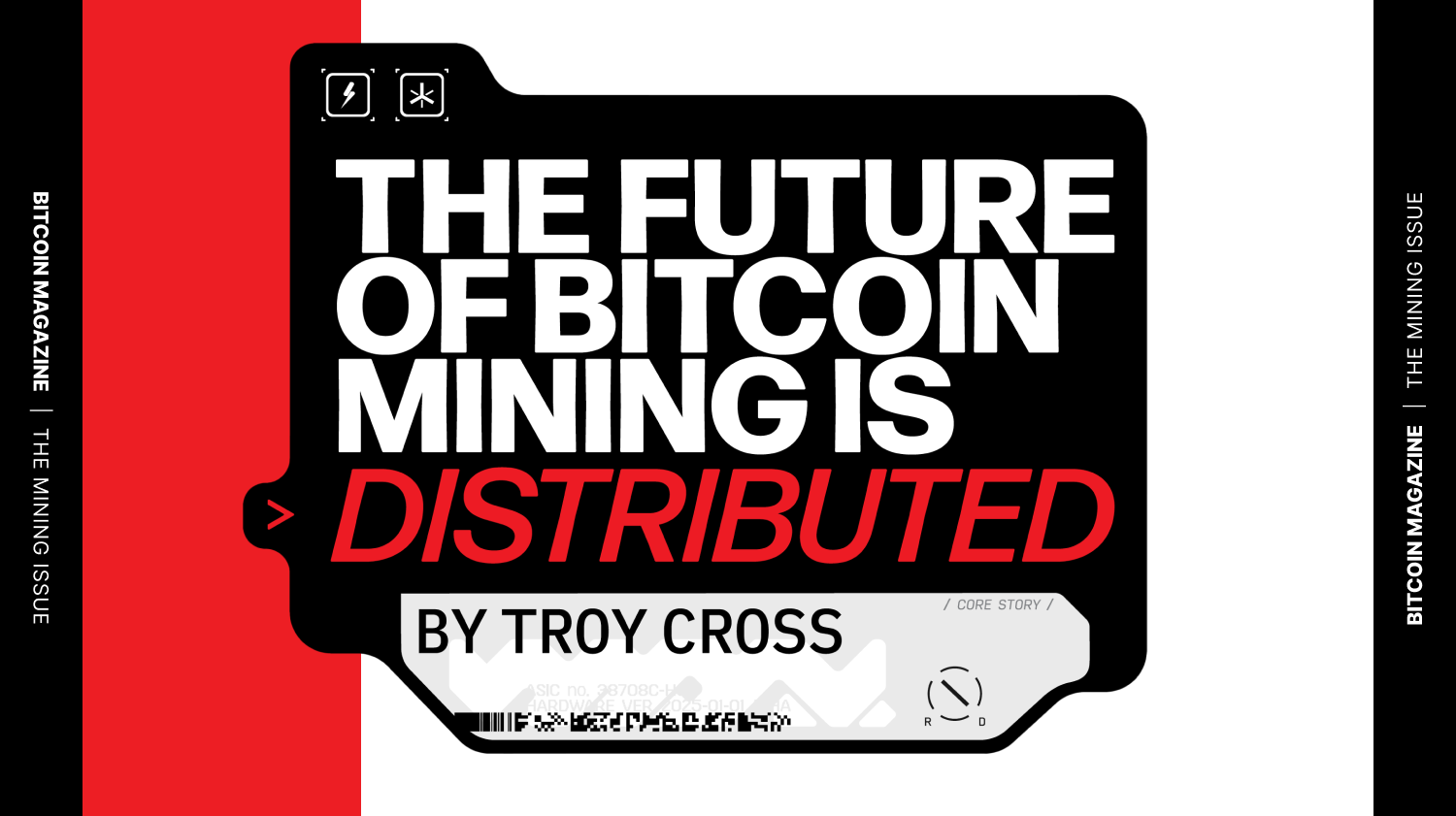Opinion
Bitcoin Developers Move to Gauge Consensus on Covenants Soft Forks
Published
4 months agoon
By
admin
A small, but significant development in Bitcoin’s much-debated decentralized consensus process is taking place, with some developers moving to publicly gauge sentiment of warring soft fork proposals that would augment the software rule set.

https://x.com/pete_rizzo_/
More specifically, the effort began today with the creation of a page on the Bitcoin Wiki website called “Covenants Support,” whereon the network’s pseudonymous developers are able to attest as to their interest in no less than nine proposals, with a six option rating system.
The effort is not affiliated with Bitcoin Core, the network’s major software implementation.
Yet, it’s notable, as the process has been evoked in past Bitcoin consensus upgrades, dating back to the first soft fork, P2SH, in 2012, and continuing through the fabled Fork Wars, with SegWit, the most contested change to date, both having dedicated Wiki pages.
Covenants, a method of restricting the spending conditions of specific UTXOs, has been gaining mindshare since 2021, with the introduction of OP_CTV, authored by developer Jeremy Rubin, though opinions differed at the time on the strength of the proposal and its promotion.
Among those being gauged for developer sentiment are OP_VAULT, a covenants scheme aimed more specifically at custody, and OP_CAT, an alteration that would bring back Satoshi-era capabilities, like the ability to perform complex code queries.
Already weighing in with their opinions are Luke Dashjr, one of the network’s longest-standing contributors, alongside newer entrants such as Jon Attack, Brandon Black, and MoonSettler.
Should the effort gain traction, the page could emerge as one to watch.
Bitcoin’s governance process, though much debated, has seldom conformed to a dedicated process, with some long-time contributors arguing against the necessity of a process at all.
Still, the move is indicative of an overall interest among the development community in moving forward with code updates that improve Bitcoin for users, though there will likely remain debate as to the preferred update, as well as the activation method that would enable it.
This article is a Take. Opinions expressed are entirely the author’s and do not necessarily reflect those of BTC Inc or Bitcoin Magazine.
Source link
You may like


Solana Eyes $200 Target As It Gains Momentum – Recovery Could Mirror 3-Month Downtrend


BTC-denominated insurance firm meanwhile secures $40m in VC funding


‘You Want To Own the Most Hated Thing’ – Arthur Hayes Says Ethereum Set To Outrun Solana As Memecoin Craze Fades


Crypto Braces for a Hidden $4.5 Trillion Catalyst for Bitcoin, Ethereum, Cardano, XRP Price


Block Agrees to $40M NYDFS Penalty Over Lackluster Compliance Program


Top Bitcoin miners produced nearly $800M of BTC in Q1 2025
Blockchain
Web3 search engine can reshape the internet’s future
Published
10 hours agoon
April 10, 2025By
admin
Disclosure: The views and opinions expressed here belong solely to the author and do not represent the views and opinions of crypto.news’ editorial.
The internet is at a crossroads. People are continuing to express their frustration and dissatisfaction with the internet—double that of what they felt 20 years ago—as centralized platforms are facing increasing scrutiny for their opaque algorithms, data exploitation, and bias in content curation.
Most online platforms today run on web2, where FAANG companies—Meta, formerly known as Facebook, Amazon, Apple, Netflix, and Alphabet, formerly known as Google—control the data, serve ads, and track users for profit. Users are ultimately the product, and while these companies have added billions in market cap by turning users into the product, this is far from the best model for creating a sustainable knowledge engine like the internet. Participants in the internet ecosystem are starting to wake up to the fact that this model doesn’t really work for anyone except those FAANG companies.
Nowhere are these problems more evident than in search. Search is one of the most fundamental activities on the internet and, thus, stands at the forefront of “gatekept content.” If the internet really is our collective knowledge engine, then search is the first step in acquiring that knowledge.
It is sometimes even the last and only step in using the internet to acquire knowledge, considering that the first result on a Google page has a clickthrough rate of over 25 percent and the tenth result, proportionately, only has a tenth of that. Presumably, a fraction of that fraction even makes it to the second page of results.
Now, consider Google’s prominent position in all of search. Even while Google’s search market share last year dropped below 90 percent for the first time in 10 years, it is still within the range of the popular vote total for a third-world dictator. So, the One True Result that has been served up by Google’s algorithm is getting a quarter of the traffic for the search engine that still holds somewhere in the area of 90 percent of the search engine market share. That’s a lot of opaque and centralized power centered in one private company.
Even while competitors like DuckDuckGo and Bing try to carve out some of their own market share by offering AI-powered search or increased privacy, as centralized companies, they fundamentally present the same problem Google does, without the market share. The integrity of our search results has never been more crucial, and we can’t leave it to web2 structures to be good custodians of that integrity, especially when the priorities of those structures to protect their users can turn on a dime.
The solution is here: Enter web3
How do we put how information is organized back into the hands of users, especially as the search engines promise to become even more inscrutable with the implementation of AI and the obscuring of sources?
One possible way to put that power back into the hands of users is what has thus far been built with web3. Web3 can allow us to build a decentralized, community-powered search engine while participating in a truly open and trustless search ecosystem. A decentralized node-powered ecosystem can ensure fair, unbiased, and censorship-resistant search results, free from the corporate agendas that have shaped traditional search engines.
Instead of relying on corporations, web3 platforms are permissionless, sovereign, and decentralized. They are powered by blockchain and smart contracts instead of centralized corporate servers that open users to vulnerabilities and data insecurity. Web3 gives users control back over their data, identity, and digital assets.
There are a host of other ways in which web3 can empower the user. These include self-sovereignty, permissionless control of assets without fear of confiscation, self-custodial staking and earning, access for the unbanked, peer-to-peer transfers, and, perhaps most important of all, that fundamental decentralization, which eliminates single points of failure while being resistant to manipulation.
There is also no behavioral profiling, no centralized control, and no data tracking. This means no censorship risk, no suppression of competing voices, and a search experience that respects user privacy.
Users must work to reclaim power
Search engines today function as gatekeepers of information, with centralized platforms deciding which content is amplified, suppressed, or monetized based on user profiles and corporate interests. Users deserve a fairer and ultimately better search experience, one where ranking algorithms are not influenced by personal data, past behavior or profit-driven agendas.
The problem is bound to get worse as the AI race heats up and companies look for new data sources on which to train these AIs. Whatever promises a centralized company might have once made to the user about not tracking or using data, again, these priorities can shift very quickly in something like an AI technology realignment. The beauty of web3 is that the structure of the technology itself prevents such exploitation.
Web3 may seem abstract right now, but it’s not all that different from the kind of technical fluency users needed to acquire as they went from the personal computer to the networked personal computer of web2. Users essentially just have to trade out an encrypted password shared with a central web service (and who knows where else) for an encrypted wallet that only they can control and access. The benefits of full control over assets and data will far outweigh whatever stumbling blocks there are to this learning curve.
Users have shown that they are willing to trade a lot for convenience, but perhaps they’ve reached a breaking point in that bargain. Now is the time for web3 to take advantage.

Timothy Enneking
Timothy Enneking is the CEO of Presearch, a decentralized, privacy-focused, web3 search engine. He was initially invited to join the project seven years ago after he recommended it during a CNBC Asia interview on crypto, and he remained an advisor for four years. He rejoined Presearch in August 2023 when the founder invited him to become the CEO and bring the project to the next level. He is the founder and Principal of Digital Capital Management, LLC (“DCM”), which runs CAF 2017, a crypto trading fund. He is also the founder and managing partner of Psalion, which manages two venture capital funds and a yield farming operation. For nine years ending in June 2024, Mr. Enneking was the Chief Investment Officer of Mana Companies Asset Management, a medium-sized family office (which did not invest in crypto). Prior to those activities, Mr. Enneking founded and managed Tera Capital Fund, a fund of funds focused on Eastern Europe (established in 2004). Simultaneously, in 2013, he was engaged to manage the world’s first Bitcoin fund. Mr. Enneking also has extensive M&A experience, having completed more than 70 transactions with an aggregate transaction value of over US$12 billion. He speaks near-native French and Russian, as well as German. He has five university degrees, all in international business and law.
Source link

Disclosure: The views and opinions expressed here belong solely to the author and do not represent the views and opinions of crypto.news’ editorial.
AI-generated avatars and virtual assistants will revolutionize our digital landscape, powering virtual influencers, workplace stand-ins, and immersive metaverse experiences. Yet, beneath this technological marvel lies a pressing question: who truly owns and controls your digital identity? The reality is stark—most AI avatars are tethered to centralized platforms where corporations hold dominion, exposing users to exploitation, financial fraud, and a profound loss of autonomy. As these digital personas become integral to our virtual lives, the need for a transformative solution has never been more urgent.
Decentralizing AI avatars through blockchain technology and smart contracts emerges as a vital antidote, promising to restore control to individuals in an increasingly virtualized world. The dangers of centralized systems are vividly demonstrated by high-profile abuses that have shaken public trust. In January 2024, a deepfake robocall mimicking U.S. President Joe Biden targeted New Hampshire voters, falsely urging Democrats to skip the primary in a bid to sway the 2024 election. This brazen act of manipulation, which prompted an FCC ruling to ban deepfake robocalls and ignited debates over AI regulation, exposed the fragility of centralized platforms that harbor the data fueling such scams.
The entertainment industry offers another stark warning. In early 2024, explicit deepfake images of Taylor Swift flooded social media, amassing over 45 million views before removal after a 17-hour delay. This incident laid bare the limitations of centralized content moderation, which often falters under pressure, leaving women and public figures disproportionately vulnerable to digital harm. The fallout was swift—Swift’s team condemned the breach, and platforms scrambled to respond, yet the delay highlighted a systemic failure to protect digital likenesses in real-time.
Additionally, Meta’s Oversight Board recently took up cases involving deepfake explicit imageries, noting inconsistent moderation practices— certain content was removed faster than others due to not passing specific community guidelines, highlighting inequities in centralized systems. These examples show how centralized avatar management leaves users powerless and unable to prevent misuse of their digital likeness.
Why AI avatars need to be decentralized
Centralized platforms trap users in ecosystems where their digital identities are subject to exploitation or sudden deactivation at corporate whim. This unchecked dominance shatters the vision of a user-empowered digital future, reducing individuals to mere cogs in a profit-driven machine. Decentralization flips this narrative, fostering self-sovereign identity where users hold the reins, owning and managing their avatars with confidence.
By placing control in the hands of individuals, decentralized systems can curb corporate overreach, ensuring AI avatars reflect their creators’ intent rather than serve as tools for exploitation.
Blockchain-powered AI ownership
Blockchain technology stands as a beacon of hope against these escalating threats. Through on-chain verification, it forges an unalterable record of avatar ownership, forging a secure bond between digital identities and their rightful owners while decisively countering unauthorized deepfake abuse.
This was painfully evident in February 2023, when a French interior designer fell pray in a romance scam: fraudsters wielded AI-generated images and messages to impersonate Brad Pitt, spinning a tale of a fabricated relationship and a fabricated cancer diagnosis that convinced her to part with €830,000—her life savings—before the deception unraveled. Such episodes unveil the dangers of centralized platforms, which hoard user data and become fertile ground for AI-driven fraud, eroding trust and inflicting devastating personal losses. Without a verifiable system to authenticate digital identities, AI-driven deception will only intensify. Users are left defenseless as deepfakes become more sophisticated and harder to detect. The challenge is clear: How can we secure digital avatars against misuse while ensuring individuals, not corporations, maintain control over their online presence?
Yet, blockchain’s potential extends further. Smart contracts bolster this framework by automating rights management, guaranteeing avatars operate with unwavering security and transparency while fortifying defenses against fraud. This comprehensive approach not only shields digital assets from theft but also alleviates the ethical and legal burdens intensified by centralized oversight, equipping users with verifiable dominion over their virtual selves.
A web3 future for AI avatars
Decentralized AI avatars can also drive a vibrant web3 economy, integrating into metaverses, digital workspaces, and decentralized social networks. These avatars can become dynamic assets—representing users in virtual worlds, facilitating remote collaboration, or enabling secure interactions online. Picture a musician selling a unique avatar on a decentralized marketplace or a professional using a blockchain-verified digital twin to authenticate their presence in a virtual meeting. This ecosystem thrives on user ownership, positioning decentralized AI avatars as a foundation for the next digital economy.
The drive to decentralize AI avatars is non-negotiable—centralized systems, exposed by explosive deepfake scandals and crumbling moderation, threaten to dismantle safety and freedom in an AI-drenched world. Blockchain carves a decisive path to empowerment, handing the reins of digital identity back to individuals, not corporate overlords. The clock is ticking: seize control of your digital destiny now, or watch it vanish into a dystopian abyss of corporate domination.

Roman Cyganov
Roman Cyganov is the founder and CEO of Antix, a company at the forefront of web3, AI, and gaming technologies. Recognized by OUTPUT as one of the Top 10 Global Talents, Roman has a rich history of driving technological innovation and redefining how businesses engage with digital audiences. Under his leadership, Antix has developed AIGE, a cutting-edge technology that crafts hyper-realistic AI-powered digital humans, revolutionizing client interactions in the digital space. Roman’s entrepreneurial journey includes co-founding VIVIX Inc., where he served as CCO before his pivotal role at Antix. His career is marked by a successful exit and numerous high-profile ventures that underscore his role as a serial entrepreneur leading the next wave of digital transformation.
Source link

In a recent video interview by Bitcoin Magazine, Troy Cross, Professor of Philosophy and Humanities at Reed College, delves into the topic of his latest article for Bitcoin Magazine’s “The Mining Issue,” titled “Why the Future of Bitcoin Mining is Distributed.” Watch the full discussion here.
In the interview, Troy explores the centralization vectors in Bitcoin mining and presents a compelling argument for the decentralization of hashrate. Despite the economies of scale that have given rise to mega mining operations, he highlights a critical—and potentially economic—imperative for distributing mining power, offering insights into the future of Bitcoin’s infrastructure.
The following article is featured in Bitcoin Magazine’s “The Mining Issue”. Subscribe to receive your copy.
Intro
When Donald Trump said he wants all the remaining bitcoin to be “MADE IN THE USA!!!” Bitcoiners cheered. Mining is good, right? We want it to happen here! And indeed, the U.S. is well on its way to dominating the industry. Publicly listed U.S. miners alone are responsible for 29% of Bitcoin’s hashrate — a percentage that only seems to be growing. Pierre Rochard, vice president of research at Riot Platforms, predicts that by 2028, U.S. miners will produce 60% of the hashrate.
But let’s be honest: Concentrating most Bitcoin mining in the U.S., especially in large public miners (as opposed to a Bitaxe in every bedroom), is a terrible idea. If the majority of miners reside in a single nation, especially a nation as rich and powerful as the U.S., miner behavior would be driven not only by Satoshi’s well-designed incentives but also by the political whims of whatever regime happens to be in power. If Trump ever gets what he said he wants, the very future of bitcoin as non-state money would be at risk.
In what follows, I outline what a nation-state attack on bitcoin through the regulation of miners would look like. Then I review the incentive structures that have pushed Bitcoin mining to large U.S. data centers under the control of a handful of companies. Finally, I make the case that the future of Bitcoin mining does not resemble its recent past. Bitcoin mining, I think, will revert to a distribution closer to its early days, where miners were as plentiful and as geographically dispersed as the nodes themselves.
I also argue that despite some Bitcoiners’ enthusiasm for “hash wars”, and despite political chest-thumping, nation-states actually have an interest in a future in which no country dominates Bitcoin mining. This “non-dominance dynamic” sets bitcoin apart from other technologies, including weapons, where the payoff for dominating drives nations in a competition to corner the market first. But with Bitcoin mining, dominating is losing. When nation-states come to understand this very unique game theory, they will help defend it against miner concentration.
The Attack
If the U.S. had the majority of hashrate, how could bitcoin be attacked?
With a single directive from the Treasury Department, the U.S. government could order miners to blacklist certain addresses from, say, North Korea or Iran. The government could also forbid miners from building on top of chains with forbidden blocks, i.e., all miners would be forbidden from adding a block to a chain containing an earlier block with a censored transaction. Large U.S. miners — public companies — would then have no choice but to follow the law; executives don’t want to go to prison.
What’s more, even miners outside the U.S., or private miners within the U.S. choosing to flout the law, would have to censor. Why? If a rogue miner snuck a forbidden transaction into a block, law-abiding miners would have to orphan that block, building directly atop of earlier, government-approved blocks. Orphaning the block would mean the rogue miner’s own reward, their coinbase transaction, would be orphaned as well, leaving the miner with nothing to show for their work.
What would happen next is unclear to me, but none of the outcomes are ideal. We would have a fork of some kind. The new fork could use a different algorithm, making all existing ASICs incompatible with the new chain. Alternatively, the fork could keep the existing algorithm, but manually invalidate blocks coming from known bad actors. Either option would leave us with a government-compliant bitcoin and a noncompliant bitcoin, where the government-compliant fork would run the original code.
When I’ve heard Bitcoiners discuss these scenarios, they usually say everyone would dump “government coin”, and buy “freedom coin”. But would that really happen? Maybe we, the readers of Bitcoin Magazine, freedom seekers, and cypherpunk types, would dump the censored fork bitcoin for the new freedom variant. But I doubt that BlackRock, Coinbase, Fidelity, and the rest of Wall Street would follow suit. So the relative economic value of these two forks, particularly another five to ten years into the future, is far from clear to me. Even if a noncompliant fork of bitcoin were to survive and retain much of its economic value, it would be weakened economically and philosophically.
Now consider the same attack scenario but with well-distributed hashrate. Suppose U.S. miners represent only 25% of the hashrate. Suppose the U.S. government forces miners to blacklist addresses, and worse, orphan any new blocks containing transactions with blacklisted addresses. This is still bad. But the 75% of miners outside of the reach of U.S. law would continue to include noncompliant transactions, so the heaviest chain would still include noncompliant blocks. If there is a fork in this distributed-mining scenario, it is the government-compliant bitcoin that would have to fork away and abandon proof of work for social consensus.
This is still a dark scenario. Custodial services in the U.S. may be forced to support the new compliant bitcoin, and that would pose an economic threat, at least for a time, to the real bitcoin. But if the mining network persists outside the U.S. and has the majority of hashrate, this seems more like the U.S. opting out of bitcoin than the U.S. co-opting bitcoin, as it could with hashrate dominance.
How Did Bitcoin Mining End up in Large U.S. Data Centers?
Bitcoin mining’s evolution is a case study in economies of scale.
Let’s go back to the beginning. What we think of as the distinctive functions of miners — collecting transactions into blocks, doing proof of work, and publishing their blocks to the network — were all part of Satoshi’s descriptions of what nodes do. There were no distinctive “miners”; every node could mine with the click of a button. So in those early days, mining was as decentralized as the nodes themselves.
But CPU mining was quickly displaced by mining on graphics cards and FPGAs, and then from 2013 onward, by ASICs. Mining remained a vestigial option on nodes for many years, until in 2016 Bitcoin Core finally dropped the pretense and removed it entirely in version 0.13.0 of the software. Once mining took on a life of its own, apart from node running, using its own specialized equipment and expertise, it started to scale. This was entirely predictable.
In The Wealth of Nations, Adam Smith describes a pin factory employing only 10 people that produces 48,000 pins per day, where each employee, all on their own, could make at most 1 pin per day. By specializing in one stage of the pin-making process, developing tools for each subtask, and combining their efforts sequentially, the employees produced far more pins with the same amount of labor. One way to think about this is that the cost of increasing production by one pin is negligible for a factory already making 48,000, having already sunk cost into the equipment and skills; it would only require a slight addition of labor and materials. But for someone producing one pin a day, the marginal cost of adding one pin to production doubles.
Mining, once freed from the CPU, had many features that lent themselves to efficiencies of scale just like making pins in a pin factory. ASICs are specialized tooling, like pin-making machines. So are the data centers designed for the special power density and cooling needs of those ASICs. Likewise, compared to mining in one’s basement, mining in a multi-megawatt commercial facility spreads the same fixed costs over many more mining units. Some examples of relatively scale-indifferent expenses encountered by miners include:
- Power expertise
- Power equipment
- Control systems expertise
- ASIC repair expertise
- Cooling expertise
- Cooling facilities
- Legal expertise
- Finance expertise
In a larger operation, not only are fixed costs absorbed by a larger number of revenue-producing machines, but one also gains bargaining power with suppliers and labor. Scaling up from one’s basement to the local commercial park, one gets a better price on electricity. Scaling up from an office park presence to a mega-center, one begins to employ power specialists who draw up sophisticated contracts with power suppliers and financially hedge against price movements. Sending one machine off for repair whenever it breaks down costs more — per repair incident — than simply hiring a repair specialist to find failing ASICs and fix them on-site, provided the scale of operation is large enough. And when dealing with ASIC manufacturers, pricing is relative to the size of the order. Major players can drive a harder bargain, squeezing smaller miners like Walmart squeezed main street shops by negotiating lower prices for their wares.
Economies of scale should surprise no one, as they apply to some degree to almost all manufactured goods. The benefits of size naturally explain how mining went from something I did with graphics cards in my basement 13 years ago to facilities approaching 1 GW today.
But that is why mining has scaled up, not why it has concentrated in the U.S. and in large public companies. To understand the latter requires noticing two more factors. The first is another good that scales: financing. Large public companies can raise cash through diluting their stock or issuing bonds. Neither of these fundraising mechanisms is available to a small-scale miner. True, they can borrow, but not on the same terms as a large company, and the U.S. has the deepest capital markets in the world. Secondly, the U.S. has “rule of law”, a relatively stable legal system, reducing the risk that, for instance, the state would seize a mining operation or that regulators would arbitrarily halt operations.
The other feature that drew mining to the U.S. in the past few years was the availability of power infrastructure. After China banned Bitcoin mining, it became profitable to mine virtually anywhere in the world with basically any ASIC. But the U.S. had available power infrastructure, much of it in the rust belt, left behind when U.S. manufacturing made an exit for China. The U.S. also had abundant power in West Texas, stranded wind and solar energy incentivized by subsidies but insufficiently interconnected to East Texas and to the rest of the country. In the wake of the China Ban, miners quickly occupied the underutilized rust-belt infrastructure and took advantage of the abundant power and cheap land to build data centers in West Texas.
The ability to raise and deploy large amounts of funding is a striking advantage, and one that compounds with others, given Bitcoin mining’s fixed, global reward. With ample funding from the markets, the largest public Bitcoin miners were able to secure the newest, most efficient, and most powerful ASICs as well as negotiate the best power contracts, hire the best experts on firmware and software, and so on. Not only did this put smaller miners at a disadvantage, but the large miners could then boost global hashrate significantly, driving up difficulty. When the price of bitcoin fell, with a debt-fueled ASIC fleet already deployed, margins shrank to almost nothing for miners that did not have the advantages of scale. Even a public miner in bankruptcy could continue running their massive fleet of machines during restructuring, driving out their smaller competitors while navigating the legal system.
Thus did mining grow from hobbyist scale to gigawatt scale, and thus did it settle in America. Mining is a brutally competitive commodity business, and the efficiencies afforded by scale proved decisive, especially when funded by debt and dilution.

Why Mining Will Be Distributed and Small-Scale Once Again
Just as there are economies of scale, there are also diseconomies of scale, where unit production costs actually increase with size at a certain point. For instance, it’s obvious why there isn’t just one gigantic food factory that feeds everyone in the world every meal. Yes, there are efficiencies in the factory production of food — witness the average farm size over the past century — but there are limits too. Fresh ingredients must be shipped to a factory and the final product then must be shipped to consumers. Both the inputs and the outputs of a food factory are perishable and heavy. Shipping costs to and from a single factory would be exorbitant, and quality would suffer in comparison to more local markets with fresher food. Similar factors explain why sawmills and paper mills are near forests, and why bottling plants are near fresh water.
But shipping bitcoin costs nothing: It’s a simple matter of making a ledger entry on the Bitcoin blockchain itself, which takes mere seconds. And although I like to brag about mining our artisanal Portland bitcoin, there are actually no local flavors of bitcoin that differ depending on where it’s made. All bitcoin is qualitatively identical. This is all the more reason global bitcoin production should centralize to the single, very best place to make bitcoin.
There’s just one problem with centralizing all mining into a single plant: Bitcoin mining is energy-intensive. In fact, it already uses more than 1% of the world’s electricity. Electricity is the primary operating cost of mining bitcoin, often representing 80% of operating expenses. And unlike bitcoin, electricity does not travel well. Not at all. In fact, electricity is a lot like food that perishes instantly and requires expensive, specialized infrastructure to transport. For electricity, that infrastructure is wires, transformers, substations, and so on — all the elements of an electrical grid.
Shipping electricity is actually much of the cost of electricity. What we call “generation” is often a minority of the total cost of electricity, which also includes “transmission and distribution” charges. And while the cost of generation continues to fall with advances in technology and manufacturing efficiency for solar panels, grid investments are only becoming more costly. So it makes no sense to ship electricity around the globe to a single bitcoin factory. Instead, bitcoin factories should sit at the sites of generation where they can avoid transmission and distribution costs altogether, and then ship the bitcoin from those sites for free. This is already happening, in fact. It’s called putting your Bitcoin mine “behind the meter”.
Mining companies will play up their differences: firmware, pools, cooling systems, finance, power expertise, management teams. But at the core of what they do, there is little to separate different mining companies from one another: The product is identical, it costs nothing to ship, and they use exactly the same machines (ASICs) to convert electricity to bitcoin. Differences in electricity cost largely determine which miners will survive and which will not. In a prolonged period of price stagnation, or even a steady rise, only those companies with access to the cheapest electricity will be operating.
The master argument, then, for a global distribution of miners in the future goes as follows. First, Bitcoin mining, by design, is driven to the cheapest energy in the world. Second, cheap energy is distributed around the world, and also “behind the meter”. So, third, mining will be geographically distributed and behind the meter too.
For the sake of argument, imagine Donald Trump’s wish is granted and all mining is in the U.S. and that mining is in equilibrium, i.e., mining margins are extremely tight. If someone finds power elsewhere in the world that is cheaper than the average U.S. miner’s, and deploys ASICs there, hashrate will increase and some U.S. miners (those with the highest expenses) will go out of business. This process will repeat until mining only happens on the cheapest energy in the world.
Cheap energy takes different forms: gas in the Middle East and in Russia; hydro projects in Kenya and Paraguay; solar in Australia, Morocco, and Texas. The reason energy is distributed is that nature has distributed it. Rain and elevation changes (i.e., rivers) are everywhere. Fossil fuel deposits are everywhere. The wind blows everywhere. The sun shines almost everywhere.
In fact, the global distribution of energy is somewhat guaranteed by the solar path around the planet. As the sun shines most brightly, its energy is bound to be wasted by solar-powered systems, as power infrastructure is never designed for peak generation. I predict that in the future, a substantial portion of the hashrate will follow the solar path, with machines using the excess solar either overclocking during that period or, if they are older and otherwise unprofitable, turning on only for that brief period when the system is producing more electricity than the grid demands.
The master argument above can be slightly modified to reach other conclusions about the future of mining. I also think, for example, that there is abundant cheap power at a small scale, and a limited amount of cheap power at a truly massive scale (100 MW+). It follows that, provided Bitcoin mining continues to grow, small-scale mining will make a return and the trend toward megamines will reverse as large-scale sources of cheap power disappear.
To see why cheap power exists mostly at the small scale, we could go on a case-by-case basis. For instance, we could look at why flare-gas waste happens in a distributed small-scale way, and why solar inverters are undersized, leading to clipped power all over the system. But I would rather think about the broader principle. Where we have cheap power at scale it is a massive mistake. For instance, the mistake may be building a dam or nuclear plant no one really needed. Massive mistakes are limited in number: They’re expensive! There is a limit to fiat stupidity.
Smaller-scale mismatches of supply and demand are going to be more common, all else equal. If gas production at an oil well is big enough, for instance, it will make sense to build a pipeline to ship it out; if it’s relatively small, it will not make sense to build the pipeline and the gas will be stranded. Likewise for landfills. The largest landfills have generators and are grid-connected, but the smaller landfills often fall short of even collecting their methane, let alone generating electricity with it and feeding that electricity to the grid. The same is true of dairy farms.
Further, bitcoin is not the only form of energy-intensive computation. If there are large quantities of cheap energy, other forms of computation will take up residence there and, being less sensitive to the price of electricity, they will outbid bitcoin miners. Those other forms, at least at present, do not scale down as well as bitcoin. It follows that the days of mining on supercheap, large-scale power are numbered. On the other hand, if you are mining bitcoin by mitigating flare gas on a desolate, windswept oil patch far from a pipeline, there is virtually no chance anyone will outbid you in order to do AI inference at your location. The same is true if you are mining on overprovisioned home solar. Small-scale energy waste is far less appealing to competitors but usable for Bitcoin miners. Mining can scale down enough to reach into these crevices of energy, whereas other kinds of energy consumers cannot.
Another version of the argument above trades on the distributed demand for waste heat. All of the electrical energy entering a bitcoin miner is conserved and leaves the miner as low-grade heat. With this waste energy, miners are heating greenhouses, villages, and bathhouses. But heating needs can typically be met with a small deployment of machines. An ASIC or two can heat a home or a swimming pool. Yet using waste heat to substitute for electrical heating improves the overall economics of mining. Other things equal, a miner selling their heat will be more profitable than a miner not selling their heat. So here is another argument that mining will be globally distributed and smaller scale: The demand for heat is globally distributed — though greater in the far north and south — and at a very limited scale.
As I’ve said, I believe Bitcoin mining will be driven to the world’s cheapest energy. But this is the trend only if the price of bitcoin rises slowly. In an aggressive bull market — and we have seen several — Bitcoin miners will use any energy available, wherever they can plug in machines. If bitcoin’s price rockets to $500,000, all my models are destroyed. But in this bullish scenario, too, mining becomes globally distributed, this time not because the cheapest power is distributed but because available power is distributed. Bitcoin at $500,000 means all ASICs are profitable on any power, and the U.S. alone does not have the infrastructure to handle that kind of demand shock even if it wanted to. So, bitcoin will be distributed either way.
It is worth noting, too, that high-margin times are short-lived, as ASIC production will always catch up, in the pursuit of profits, driving margins back down. So, over the long term, the distribution of Bitcoin miners will still be determined by the distribution of the world’s cheapest energy.
For my arguments to work, the diseconomies of scale must outweigh the economies of scale listed above. To determine the balance of these two requires nothing less than a deep dive into the spreadsheets of each kind of mining business, which would be inappropriate here.
Suffice it to say I believe that if the difference in the cost of electricity is great enough, then it outweighs everything else. But I can’t pretend to have provided anything like a proof here. These are the broad strokes; the finer details remain an exercise for the reader.
Geopolitics
Thus far, I’ve contemplated miner incentives without regard to nation-states themselves. We know that just as some countries are buying bitcoin, others are mining bitcoin with their energy resources. Nation-states have incentives independent of anything Satoshi contemplated. For instance, Iran may mine bitcoin in order to monetize its oil because sanctions make selling it on the open market impossible, or expensive at any rate. Russia may mine for similar reasons. Such nation-state actors could “mine at a loss” relative to a miner paying for their own power, because the nation-state’s cost of energy is subsidized by the taxpayer. Their mining at scale, in turn, could make it less profitable for everyone else, and push marginally profitable miners out of business.
I do not see nation-state mining as ultimately concentrating hashpower, however. As things stand, mining in Russia and Iran is actually good for bitcoin, as it checks the advance of mining by U.S. public companies, which dwarf them in scale. Moreover, if some nation-state begins to produce a disproportionate share of the hashrate, while bitcoin is an important piece of the global economy, I expect other nation-states with a stake in bitcoin’s success — or even large bitcoin holders — would also begin to mine at a loss in order to keep mining decentralized.
The game theory here is not intuitive. Rather than a competition to dominate, bitcoin is a game in which everyone wins when no one dominates and everyone loses when anyone dominates. For virtually every other technology or weapons system in the world, the best strategy is to achieve global dominance. Thus, we see a race to dominance in battery technology, chip manufacturing, drones, AI, and so on. This is called the “Thucydides trap” in foreign policy because it dictates a preemptive attack on a rising rival: The reward is immense for coming in first, and the loss is incalculable for coming in second.
But if you dominate Bitcoin mining, that is bad for Bitcoin mining, and therefore bad for bitcoin and therefore bad for you. As Bitcoin mining concentrates in one nation, everyone sees the possibility of an attack on the neutrality of bitcoin, which lies at the core of its value proposition. For instance, Russia might hold bitcoin to avoid the U.S. freezing its reserves, as the U.S. did with Russia’s fiat reserves upon their invasion of Ukraine. But if mining is concentrated in the U.S., Russia could not trust that their addresses wouldn’t be blacklisted by the U.S. Treasury Department. Russia, therefore, would dump its bitcoin for some other asset if it saw this threat arising. Miners in the U.S. would see their share of block rewards rise as they achieved dominance over other miners, but the value of their block rewards would drop as the price of bitcoin itself dropped. Other things equal, then, miners in the U.S. would not want Russians to stop mining and dump their bitcoin. U.S. miners should not want to “win”, at least not in this way. And if bitcoin is a meaningful enough part of the U.S. economy, the U.S. itself should not want its miners to win. Rather, if any nation approaches dominance, we should expect those heavily invested in bitcoin, including nation-states, to mine enough to prevent losses to their own investments.
Bitcoiners should hope that the USA will mine enough bitcoin that no country, including itself, mines a majority of it. That’s a terrible slogan for a campaign rally, and it doesn’t capture the imagination like “hash wars”. But as a Bitcoiner, it is the only rational preference one should have.

Disclaimer: Opinions expressed are entirely the author’s and do not necessarily reflect those of BTC Inc or Bitcoin Magazine.
Source link

Solana Eyes $200 Target As It Gains Momentum – Recovery Could Mirror 3-Month Downtrend

BTC-denominated insurance firm meanwhile secures $40m in VC funding

‘You Want To Own the Most Hated Thing’ – Arthur Hayes Says Ethereum Set To Outrun Solana As Memecoin Craze Fades

Crypto Braces for a Hidden $4.5 Trillion Catalyst for Bitcoin, Ethereum, Cardano, XRP Price

Block Agrees to $40M NYDFS Penalty Over Lackluster Compliance Program

Top Bitcoin miners produced nearly $800M of BTC in Q1 2025

Tariffs, Trade Tensions May Be Positive for Bitcoin (BTC) Adoption in Medium Term: Grayscale

The U.S. Tariff War With China Is Good For Bitcoin Mining

Dogecoin Bull Div Plays Out, Analyst Maps Next Price Targets

Web3 search engine can reshape the internet’s future

Billionaire Ray Dalio Says He’s ‘Very Concerned’ About Trump Tariffs, Predicts Worldwide Economic Slowdown

Top 4 Altcoins to Sell Before US-China Trade War Extends Beyond 125% Tariffs

OpenAI Countersues Elon Musk, Accuses Billionaire of ‘Bad-Faith Tactics’

81.6% of XRP supply is in profit, but traders in Korea are turning bearish — Here is why

Stablecoins Are ‘WhatsApp Moment’ for Money Transfers, a16z Says

Arthur Hayes, Murad’s Prediction For Meme Coins, AI & DeFi Coins For 2025

Expert Sees Bitcoin Dipping To $50K While Bullish Signs Persist

Aptos Leverages Chainlink To Enhance Scalability and Data Access

Bitcoin Could Rally to $80,000 on the Eve of US Elections

Crypto’s Big Trump Gamble Is Risky

Sonic Now ‘Golden Standard’ of Layer-2s After Scaling Transactions to 16,000+ per Second, Says Andre Cronje

Institutional Investors Go All In on Crypto as 57% Plan to Boost Allocations as Bull Run Heats Up, Sygnum Survey Reveals

Ripple-SEC Case Ends, But These 3 Rivals Could Jump 500x

Has The Bitcoin Price Already Peaked?

A16z-backed Espresso announces mainnet launch of core product

Xmas Altcoin Rally Insights by BNM Agent I

The Future of Bitcoin: Scaling, Institutional Adoption, and Strategic Reserves with Rich Rines

Blockchain groups challenge new broker reporting rule

I’m Grateful for Trump’s Embrace of Bitcoin

Trump’s Coin Is About As Revolutionary As OneCoin
Trending

 24/7 Cryptocurrency News5 months ago
24/7 Cryptocurrency News5 months agoArthur Hayes, Murad’s Prediction For Meme Coins, AI & DeFi Coins For 2025

 Bitcoin3 months ago
Bitcoin3 months agoExpert Sees Bitcoin Dipping To $50K While Bullish Signs Persist

 24/7 Cryptocurrency News3 months ago
24/7 Cryptocurrency News3 months agoAptos Leverages Chainlink To Enhance Scalability and Data Access

 Bitcoin5 months ago
Bitcoin5 months agoBitcoin Could Rally to $80,000 on the Eve of US Elections

 Opinion5 months ago
Opinion5 months agoCrypto’s Big Trump Gamble Is Risky

 Altcoins2 months ago
Altcoins2 months agoSonic Now ‘Golden Standard’ of Layer-2s After Scaling Transactions to 16,000+ per Second, Says Andre Cronje

 Bitcoin5 months ago
Bitcoin5 months agoInstitutional Investors Go All In on Crypto as 57% Plan to Boost Allocations as Bull Run Heats Up, Sygnum Survey Reveals

 Price analysis5 months ago
Price analysis5 months agoRipple-SEC Case Ends, But These 3 Rivals Could Jump 500x


